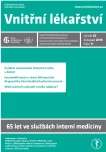Why rapid achievement of goal blood pressure is important in the treatment of arterial hypertension
Authors:
Peter Wohlfahrt; Renata Cífková
Authors‘ workplace:
Centrum kardiovaskulární prevence 1. LF UK a Thomayerovy nemocnice, Praha
Published in:
Vnitř Lék 2019; 65(11): 698-697
Category:
Overview
Currently, there is a change in the algorithm of hypertension treatment, introducing its simplification. While in the past a careful stepwise titration of antihypertensive drugs was used, the current European Society of Hypertension Guidelines prefer a more aggressive and rapid approach to combination treatment as the initial step with the aim to achieve the goal blood pressure within three months. This review summarizes changes in recommendations and evidence supporting a more aggressive treatment of hypertension.
Keywords:
hypolipidemic drugs – arterial hypertension – goal blood pressure
Sources
- Lawes CM, Vander Hoorn S, Rodgers A. [International Society of Hypertension]. Global burden of blood-pressure-related disease, 2001. Lancet 2008; 371(9623): 1513–1518. Dostupné z DOI: <http://doi: 10.1016/S0140–6736(08)60655–8>.
- [NCD Risk Factor Collaboration (NCD-RisC)]. Long-term and recent trends in hypertension awareness, treatment, and control in 12 high-income countries: an analysis of 123 nationally representative surveys. Lancet 2019; 394(10199): 639–651. Dostupné z DOI: <http://doi: 10.1016/S0140–6736(19)31145–6>.
- Geldsetzer P, Manne-Goehler J, Marcus ME et al. The state of hypertension care in 44 low-income and middle-income countries: a cross-sectional study of nationally representative individual-level data from 1.1 million adults. Lancet 2019; 394(10199): 652–662. Dostupné z DOI: <http://doi: 10.1016/S0140–6736(19)30955–9>.
- Cifkova R, Bruthans J, Wohlfahrt P et al. 30-year trends in blood pressure, prevalence, awareness, treatment and control of hypertension in the Czech republic. The Czech Monica and Czech Post-Monica studies. J Hypertens 2019; 37:e47. Dostupné z DOI: <http://doi: 10.1097/01.hjh.0000570844.48162.8b>.
- Williams B, Mancia G, Spiering W et al. [ESC Scientific Document Group]. 2018 ESC/ESH Guidelines for the management of arterial hypertension. Eur Heart J 2018; 39(33): 3021–3104. Dostupné z DOI: <http://doi: 10.1093/eurheartj/ehy339>.
- Corrao G, Parodi A, Zambon A et al. Reduced discontinuation of antihypertensive treatment by two-drug combination as first step. Evidence from daily life practice. J Hypertens 2010; 28(7): 1584–1590. Dostupné z DOI: <http://doi: 10.1097/HJH.0b013e328339f9fa>.
- Mancia G, Zambon A, Soranna D et al. Factors involved in the discontinuation of antihypertensive drug therapy: an analysis from real life data. J Hypertens 2014; 32(8): 1708–1715; discussion 1716. Dostupné z DOI: <http://doi: 10.1097/HJH.0000000000000222>.
- Mancia G, Asmar R, Amodeo C et al. Comparison of single-pill strategies first line in hypertension: perindopril/amlodipine versus valsartan/amlodipine. J Hypertens 2015; 33(2): 401–411. Dostupné z DOI: <http://doi: 10.1097/HJH.0000000000000409>.
- Simons LA, Chung E, Ortiz M. Long-term persistence with single-pill, fixed-dose combination therapy versus two pills of amlodipine and perindopril for hypertension: Australian experience. Curr Med Res Opin 2017; 33(10): 1783–1787. Dostupné z DOI: <http://doi: 10.1080/03007995.2017.1367275>.
- Rea F, Corrao G, Merlino L et al. Early cardiovascular protection by initial two-drug fixed-dose combination treatment vs. monotherapy in hypertension. Eur Heart J 2018; 39(40): 3654–3661. Dostupné z DOI: <http://doi: 10.1093/eurheartj/ehy420>.
- Gradman AH, Parise H, Lefebvre P et al. Initial combination therapy reduces the risk of cardiovascular events in hypertensive patients: a matched cohort study. Hypertension 2013; 61(2): 309–318. Dostupné z DOI: <http://doi: 10.1161/HYPERTENSIONAHA.112.201566>.
- Xu W, Goldberg SI, Shubina M et al. Optimal systolic blood pressure target, time to intensification, and time to follow-up in treatment of hypertension: population based retrospective cohort study. BMJ 2015; 350: h158. Dostupné z DOI: <http://doi: 10.1136/bmj.h158>.
- Weir MR, Hsueh WA, Nesbitt SD et al. A titrate-to-goal study of switching patients uncontrolled on antihypertensive monotherapy to fixed-dose combinations of amlodipine and olmesartan medoxomil ± hydrochlorothiazide. J Clin Hypertens (Greenwich) 2011; 13(6): 404–412. Dostupné z DOI: <http://doi: 10.1111/j.1751–7176.2011.00437>.
- Volpe M, Christian Rump L, Ammentorp B et al. Efficacy and safety of triple antihypertensive therapy with the olmesartan/amlodipine/hydrochlorothiazide combination. Clin Drug Investig 2012; 32(10): 649–664. Dostupné z DOI: <http://doi: 10.2165/11636320–000000000–00000>.
- Fung V, Huang J, Brand R et al. Hypertension treatment in a medicare population: adherence and systolic blood pressure control. Clin Ther 2007; 29(5): 972–984. Dostupné z DOI: <http://doi: 10.1016/j.clinthera.2007.05.010>.
- Bahiru E, de Cates AN, Farr MR et al. Fixed-dose combination therapy for the prevention of atherosclerotic cardiovascular diseases. Cochrane Database Syst Rev 2017; 6;3:CD009868. Dostupné z DOI: <http://doi: 10.1002/14651858.CD009868.pub3>.
- Toth K. [PIANIST Investigators]. Antihypertensive efficacy of triple combination perindopril/indapamide plus amlodipine in high-risk hypertensives: results of the PIANIST study (Perindopril-Indapamide plus AmlodipiNe in high rISk hyperTensive patients). Am J Cardiovasc Drugs 2014; 14(2):137–145. Dostupné z DOI: <http://doi: 10.1007/s40256–014–0067–2>.
- Neutel JM, Smith DH. Hypertension management: rationale for triple therapy based on mechanisms of action. Cardiovasc Ther 2013; 31(5): 251–258. Dostupné z DOI: <http://doi: 10.1111/1755–5922.12015>.
- Wright JT, jr, Williamson JD, Whelton PK et al. [SPRINT Research Group]. A Randomized Trial of Intensive versus Standard Blood-Pressure Control. N Engl J Med 2015; 373(22): 2103–2116. Dostupné z DOI: <http://doi: 10.1056/NEJMoa1511939>.
Labels
Diabetology Endocrinology Internal medicineArticle was published in
Internal Medicine

2019 Issue 11
Most read in this issue
- Functional gastrointestinal disorders and pain
- Interferon-alpha in the treatment of myeloproliferative diseases
- Vitamin D deficiency and its health effects
- Immunodeficiency in the differential diagnosis of interstitial lung diseases
